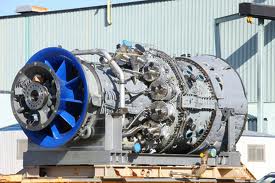Numerical simulation and prototype testing of gas turbine with hot spinning process
Keywords:
Numerical simulation; 3-D modeling; Structural strength; Thermal stress; Mechanical efficiency; Computational methodologyAbstract
The gas turbine is normally operating in high temperature environment and its blades / rotor are constantly contacting gas with extremely high temperature. To prolong the life cycle and improve the function of these critical turbine components, the cooling methods should be applied to reduce the temperature in turbine disc area. But the potential problem is that the cooling methodology reducing the central rotor temperature can enlarge the temperature gradients leading excessive thermal stresses in gas turbine components including turbine wheel. One computational simulation model is introduced in this paper to describe the mechanism of mechanical and thermal stresses produced in gas turbine to illustrate the influence of some important parameters on this gas turbine function and help to optimize the turbine wheel design. Since there are few related numerical analytic simulations that have been done in this research field, this paper intends to provide the numerical simulation methodology to investigate and understand the stress mechanism in gas turbine operation. The turbine model has also been prototyped and tested to compare the numerical simulation results. All these studies can help to optimize future gas turbine design and improve the performance.References
Beebe, R., 2009. Condition Monitoring by Performance Analysis to Optimize Time for Overhaul of Centrifugal Pumps. J. Eng. 4, 102-112.
Carey, V., 2010. Assessment of Tesla Turbine Performance for Small Scale Rankine Combined Heat and Power Systems. J. Eng. for Gas Turbine and Power. 132, 50-58.
Christodoulou, F., Giannakakis, P., Kalfas, A., 2011. Performance Benefits of a Portable Hybrid Micro-Gas Turbine Power System for Automotive Applications. J. Eng. for Gas Turbine and Power. 133, 86-94.
Kim, D., Kim, D., Choi, W., Kang, J., 2011. Dynamics Simulations of a Graphite Block Under Longitudinal Impact. J. Eng. for Gas Turbine and Power. 133, 38-45.
Komandur, S., Sunder, R., 2008. Last Stage Performance Considerations in Low-Pressure Turbines of Power Plants: A Case Study. J. Eng. for Gas Turbine and Power, 130, 38-45.
MacLeod, J., Jastremski, J., 2010. Development of a Unique Icing Spray System for a New Facility for Certification of Large Turbofan Engines. J. Aerospace, 2, 238-248.
Ogbonnaya, E., Ugwu, H., Johnson, C., 2010. Computer-Aided Solution to the Vibra-tional Effect of Instabilities in Gas Turbine Compressors. J. Eng. 2, 658-664.
Ogbonnaya, E., 2011. Gas Turbine Performance Optimization Using Compressor Online Water Washing Technique. J. Eng. 3, 500-507.
Saravanamuttoo, H., Rogers, G., Cohen, H., 2009. Gas Turbine Theory. Sixth ed., Bristol, UK.
Silva, D., Barbosa, J., Adade, A., 2011. Multivariable Aircraft Engine Controller Design Using an Optimal Loop Shaping Approach. J. Aerospace. 4, 661-671.
Singh, P., Nestmann, F., 2011. A Consolidated Model for the Turbine Operation of Centrifugal Pumps. J. Eng. for Gas Turbine and Power. 133, 102-111.
Vallee, C., Beyer, M., Jucas, D., Carl, H., 2009. Air/Water Counter-Current Flow Experiments in a Model of the Hot Leg of a Pressurized Water Reactor. J. Eng. for Gas Turbine and Power. 131, 38-46.

Published
How to Cite
Issue
Section
License
Copyright (c) 2013 Jeremy (Zheng) Li

This work is licensed under a Creative Commons Attribution-NonCommercial-NoDerivatives 4.0 International License.



